BSBRSK501 Risk Management: Applying AS/NZS ISO 31000 in Workplace
VerifiedAdded on 2023/06/11
|21
|5344
|268
Report
AI Summary
This report provides a detailed analysis of risk management, focusing on the implementation of AS/NZS ISO 31000:2009 standards. It covers five key implementation steps, differentiates between Acts, Regulations, and Codes of Practice, and examines organizational policies for risk management. The report also addresses adjusting risk management for disabled employees/customers, monitoring risk management plans, and communicating these plans to stakeholders. A major activity section presents a safety risk scenario, applying relevant legal frameworks like the WHS Act 2011 and standards such as AS/NZS 4360:2004. The analysis includes identifying risk areas, applying risk mitigation strategies, defining responsibilities, and conducting PEST and SWOT analyses. The report further details risk assessment, prioritization, action planning, and communication strategies to minimize risks and ensure workplace safety, emphasizing the importance of documentation and continuous evaluation.
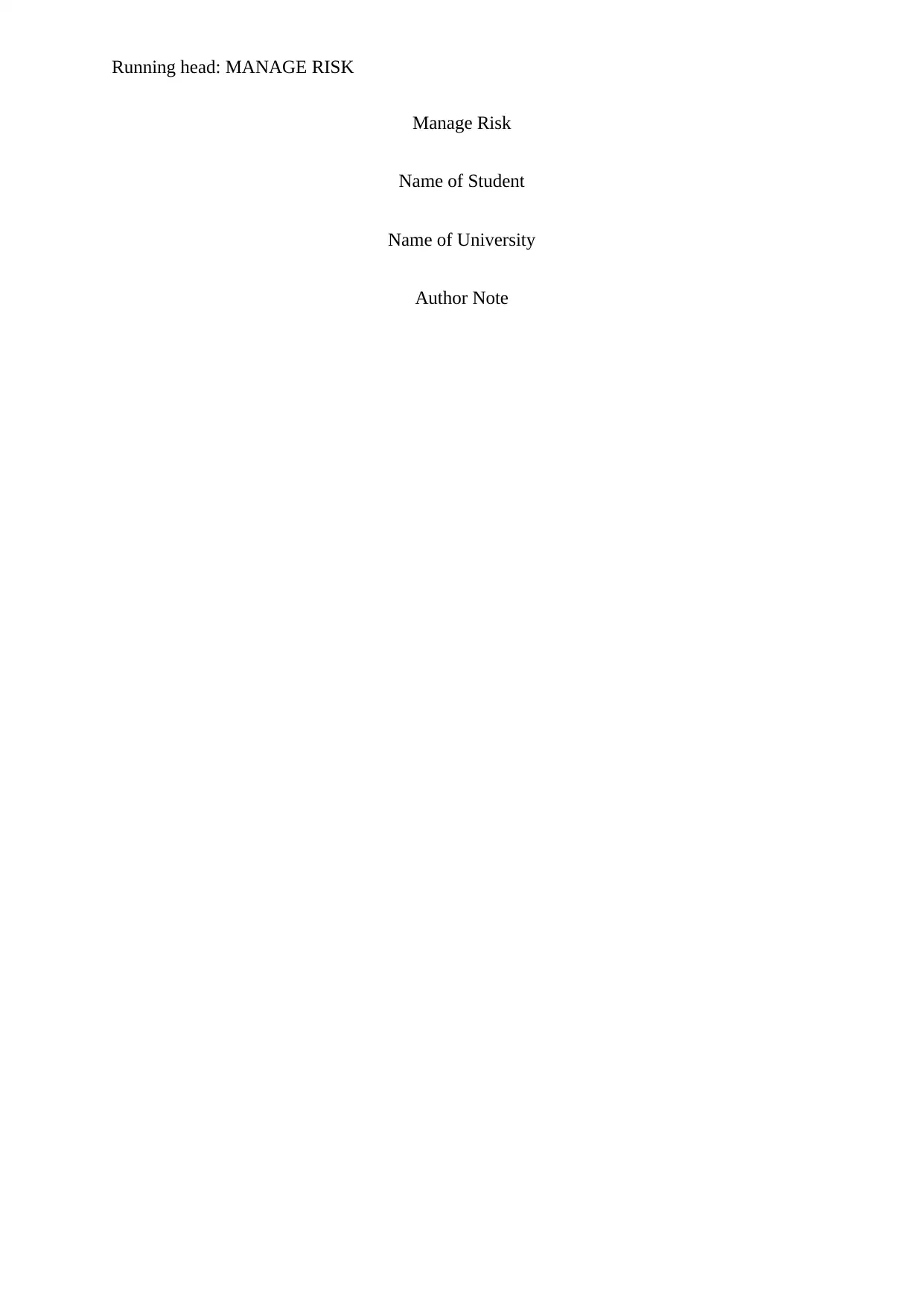
Running head: MANAGE RISK
Manage Risk
Name of Student
Name of University
Author Note
Manage Risk
Name of Student
Name of University
Author Note
Paraphrase This Document
Need a fresh take? Get an instant paraphrase of this document with our AI Paraphraser
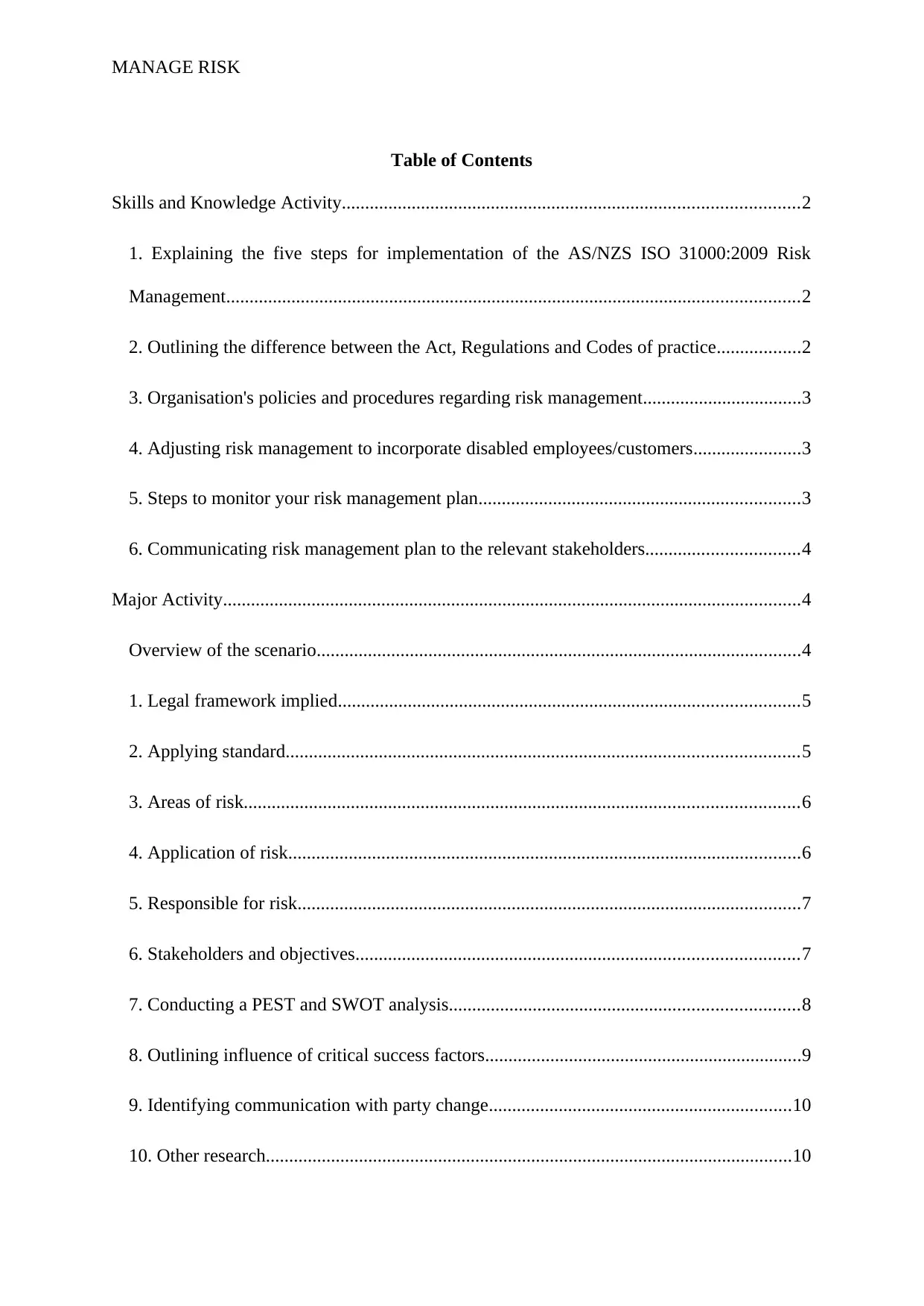
MANAGE RISK
Table of Contents
Skills and Knowledge Activity..................................................................................................2
1. Explaining the five steps for implementation of the AS/NZS ISO 31000:2009 Risk
Management...........................................................................................................................2
2. Outlining the difference between the Act, Regulations and Codes of practice..................2
3. Organisation's policies and procedures regarding risk management..................................3
4. Adjusting risk management to incorporate disabled employees/customers.......................3
5. Steps to monitor your risk management plan.....................................................................3
6. Communicating risk management plan to the relevant stakeholders.................................4
Major Activity............................................................................................................................4
Overview of the scenario........................................................................................................4
1. Legal framework implied...................................................................................................5
2. Applying standard..............................................................................................................5
3. Areas of risk.......................................................................................................................6
4. Application of risk..............................................................................................................6
5. Responsible for risk............................................................................................................7
6. Stakeholders and objectives...............................................................................................7
7. Conducting a PEST and SWOT analysis...........................................................................8
8. Outlining influence of critical success factors....................................................................9
9. Identifying communication with party change.................................................................10
10. Other research.................................................................................................................10
Table of Contents
Skills and Knowledge Activity..................................................................................................2
1. Explaining the five steps for implementation of the AS/NZS ISO 31000:2009 Risk
Management...........................................................................................................................2
2. Outlining the difference between the Act, Regulations and Codes of practice..................2
3. Organisation's policies and procedures regarding risk management..................................3
4. Adjusting risk management to incorporate disabled employees/customers.......................3
5. Steps to monitor your risk management plan.....................................................................3
6. Communicating risk management plan to the relevant stakeholders.................................4
Major Activity............................................................................................................................4
Overview of the scenario........................................................................................................4
1. Legal framework implied...................................................................................................5
2. Applying standard..............................................................................................................5
3. Areas of risk.......................................................................................................................6
4. Application of risk..............................................................................................................6
5. Responsible for risk............................................................................................................7
6. Stakeholders and objectives...............................................................................................7
7. Conducting a PEST and SWOT analysis...........................................................................8
8. Outlining influence of critical success factors....................................................................9
9. Identifying communication with party change.................................................................10
10. Other research.................................................................................................................10
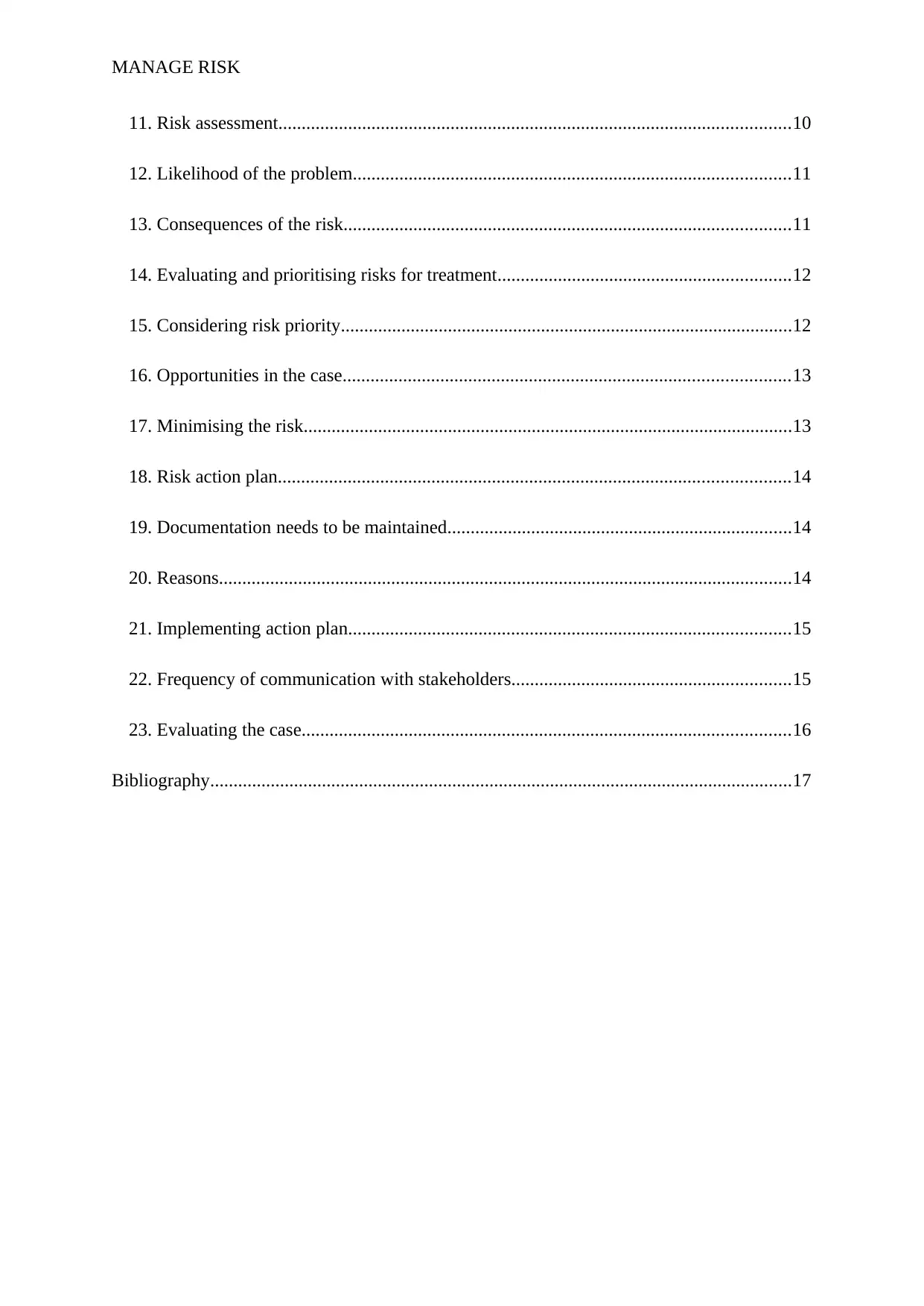
MANAGE RISK
11. Risk assessment..............................................................................................................10
12. Likelihood of the problem..............................................................................................11
13. Consequences of the risk................................................................................................11
14. Evaluating and prioritising risks for treatment...............................................................12
15. Considering risk priority.................................................................................................12
16. Opportunities in the case................................................................................................13
17. Minimising the risk.........................................................................................................13
18. Risk action plan..............................................................................................................14
19. Documentation needs to be maintained..........................................................................14
20. Reasons...........................................................................................................................14
21. Implementing action plan...............................................................................................15
22. Frequency of communication with stakeholders............................................................15
23. Evaluating the case.........................................................................................................16
Bibliography.............................................................................................................................17
11. Risk assessment..............................................................................................................10
12. Likelihood of the problem..............................................................................................11
13. Consequences of the risk................................................................................................11
14. Evaluating and prioritising risks for treatment...............................................................12
15. Considering risk priority.................................................................................................12
16. Opportunities in the case................................................................................................13
17. Minimising the risk.........................................................................................................13
18. Risk action plan..............................................................................................................14
19. Documentation needs to be maintained..........................................................................14
20. Reasons...........................................................................................................................14
21. Implementing action plan...............................................................................................15
22. Frequency of communication with stakeholders............................................................15
23. Evaluating the case.........................................................................................................16
Bibliography.............................................................................................................................17
⊘ This is a preview!⊘
Do you want full access?
Subscribe today to unlock all pages.

Trusted by 1+ million students worldwide
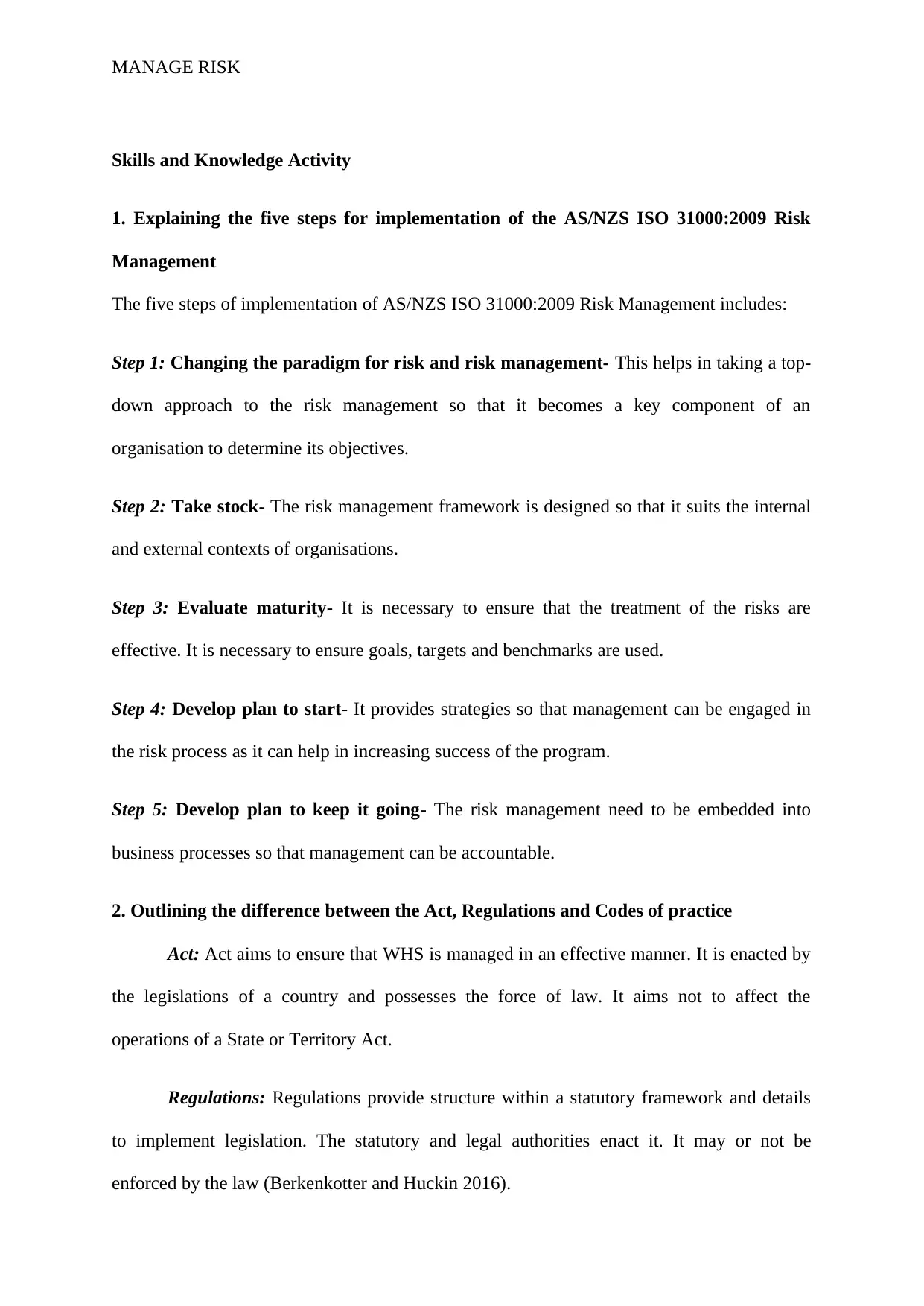
MANAGE RISK
Skills and Knowledge Activity
1. Explaining the five steps for implementation of the AS/NZS ISO 31000:2009 Risk
Management
The five steps of implementation of AS/NZS ISO 31000:2009 Risk Management includes:
Step 1: Changing the paradigm for risk and risk management- This helps in taking a top-
down approach to the risk management so that it becomes a key component of an
organisation to determine its objectives.
Step 2: Take stock- The risk management framework is designed so that it suits the internal
and external contexts of organisations.
Step 3: Evaluate maturity- It is necessary to ensure that the treatment of the risks are
effective. It is necessary to ensure goals, targets and benchmarks are used.
Step 4: Develop plan to start- It provides strategies so that management can be engaged in
the risk process as it can help in increasing success of the program.
Step 5: Develop plan to keep it going- The risk management need to be embedded into
business processes so that management can be accountable.
2. Outlining the difference between the Act, Regulations and Codes of practice
Act: Act aims to ensure that WHS is managed in an effective manner. It is enacted by
the legislations of a country and possesses the force of law. It aims not to affect the
operations of a State or Territory Act.
Regulations: Regulations provide structure within a statutory framework and details
to implement legislation. The statutory and legal authorities enact it. It may or not be
enforced by the law (Berkenkotter and Huckin 2016).
Skills and Knowledge Activity
1. Explaining the five steps for implementation of the AS/NZS ISO 31000:2009 Risk
Management
The five steps of implementation of AS/NZS ISO 31000:2009 Risk Management includes:
Step 1: Changing the paradigm for risk and risk management- This helps in taking a top-
down approach to the risk management so that it becomes a key component of an
organisation to determine its objectives.
Step 2: Take stock- The risk management framework is designed so that it suits the internal
and external contexts of organisations.
Step 3: Evaluate maturity- It is necessary to ensure that the treatment of the risks are
effective. It is necessary to ensure goals, targets and benchmarks are used.
Step 4: Develop plan to start- It provides strategies so that management can be engaged in
the risk process as it can help in increasing success of the program.
Step 5: Develop plan to keep it going- The risk management need to be embedded into
business processes so that management can be accountable.
2. Outlining the difference between the Act, Regulations and Codes of practice
Act: Act aims to ensure that WHS is managed in an effective manner. It is enacted by
the legislations of a country and possesses the force of law. It aims not to affect the
operations of a State or Territory Act.
Regulations: Regulations provide structure within a statutory framework and details
to implement legislation. The statutory and legal authorities enact it. It may or not be
enforced by the law (Berkenkotter and Huckin 2016).
Paraphrase This Document
Need a fresh take? Get an instant paraphrase of this document with our AI Paraphraser
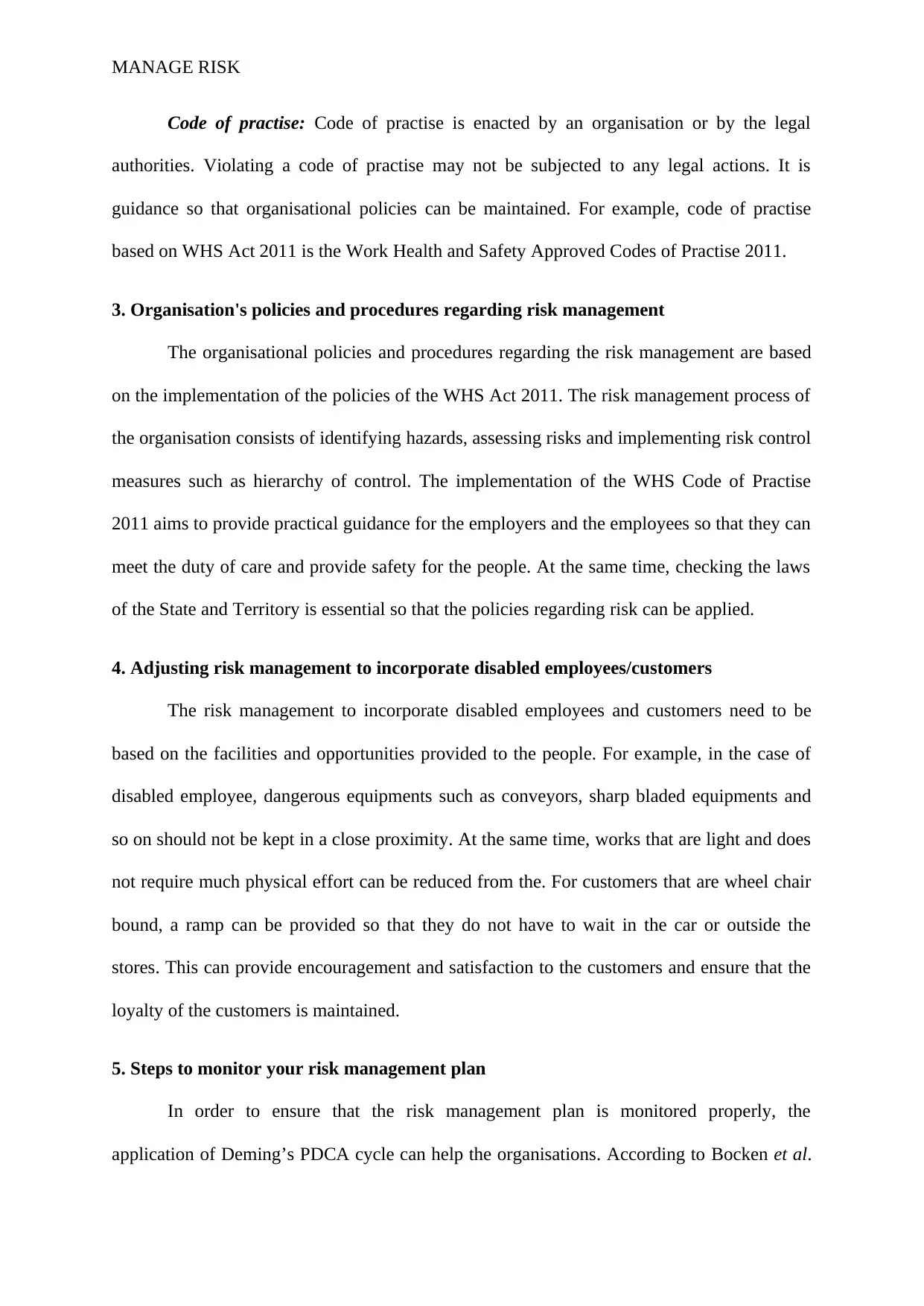
MANAGE RISK
Code of practise: Code of practise is enacted by an organisation or by the legal
authorities. Violating a code of practise may not be subjected to any legal actions. It is
guidance so that organisational policies can be maintained. For example, code of practise
based on WHS Act 2011 is the Work Health and Safety Approved Codes of Practise 2011.
3. Organisation's policies and procedures regarding risk management
The organisational policies and procedures regarding the risk management are based
on the implementation of the policies of the WHS Act 2011. The risk management process of
the organisation consists of identifying hazards, assessing risks and implementing risk control
measures such as hierarchy of control. The implementation of the WHS Code of Practise
2011 aims to provide practical guidance for the employers and the employees so that they can
meet the duty of care and provide safety for the people. At the same time, checking the laws
of the State and Territory is essential so that the policies regarding risk can be applied.
4. Adjusting risk management to incorporate disabled employees/customers
The risk management to incorporate disabled employees and customers need to be
based on the facilities and opportunities provided to the people. For example, in the case of
disabled employee, dangerous equipments such as conveyors, sharp bladed equipments and
so on should not be kept in a close proximity. At the same time, works that are light and does
not require much physical effort can be reduced from the. For customers that are wheel chair
bound, a ramp can be provided so that they do not have to wait in the car or outside the
stores. This can provide encouragement and satisfaction to the customers and ensure that the
loyalty of the customers is maintained.
5. Steps to monitor your risk management plan
In order to ensure that the risk management plan is monitored properly, the
application of Deming’s PDCA cycle can help the organisations. According to Bocken et al.
Code of practise: Code of practise is enacted by an organisation or by the legal
authorities. Violating a code of practise may not be subjected to any legal actions. It is
guidance so that organisational policies can be maintained. For example, code of practise
based on WHS Act 2011 is the Work Health and Safety Approved Codes of Practise 2011.
3. Organisation's policies and procedures regarding risk management
The organisational policies and procedures regarding the risk management are based
on the implementation of the policies of the WHS Act 2011. The risk management process of
the organisation consists of identifying hazards, assessing risks and implementing risk control
measures such as hierarchy of control. The implementation of the WHS Code of Practise
2011 aims to provide practical guidance for the employers and the employees so that they can
meet the duty of care and provide safety for the people. At the same time, checking the laws
of the State and Territory is essential so that the policies regarding risk can be applied.
4. Adjusting risk management to incorporate disabled employees/customers
The risk management to incorporate disabled employees and customers need to be
based on the facilities and opportunities provided to the people. For example, in the case of
disabled employee, dangerous equipments such as conveyors, sharp bladed equipments and
so on should not be kept in a close proximity. At the same time, works that are light and does
not require much physical effort can be reduced from the. For customers that are wheel chair
bound, a ramp can be provided so that they do not have to wait in the car or outside the
stores. This can provide encouragement and satisfaction to the customers and ensure that the
loyalty of the customers is maintained.
5. Steps to monitor your risk management plan
In order to ensure that the risk management plan is monitored properly, the
application of Deming’s PDCA cycle can help the organisations. According to Bocken et al.
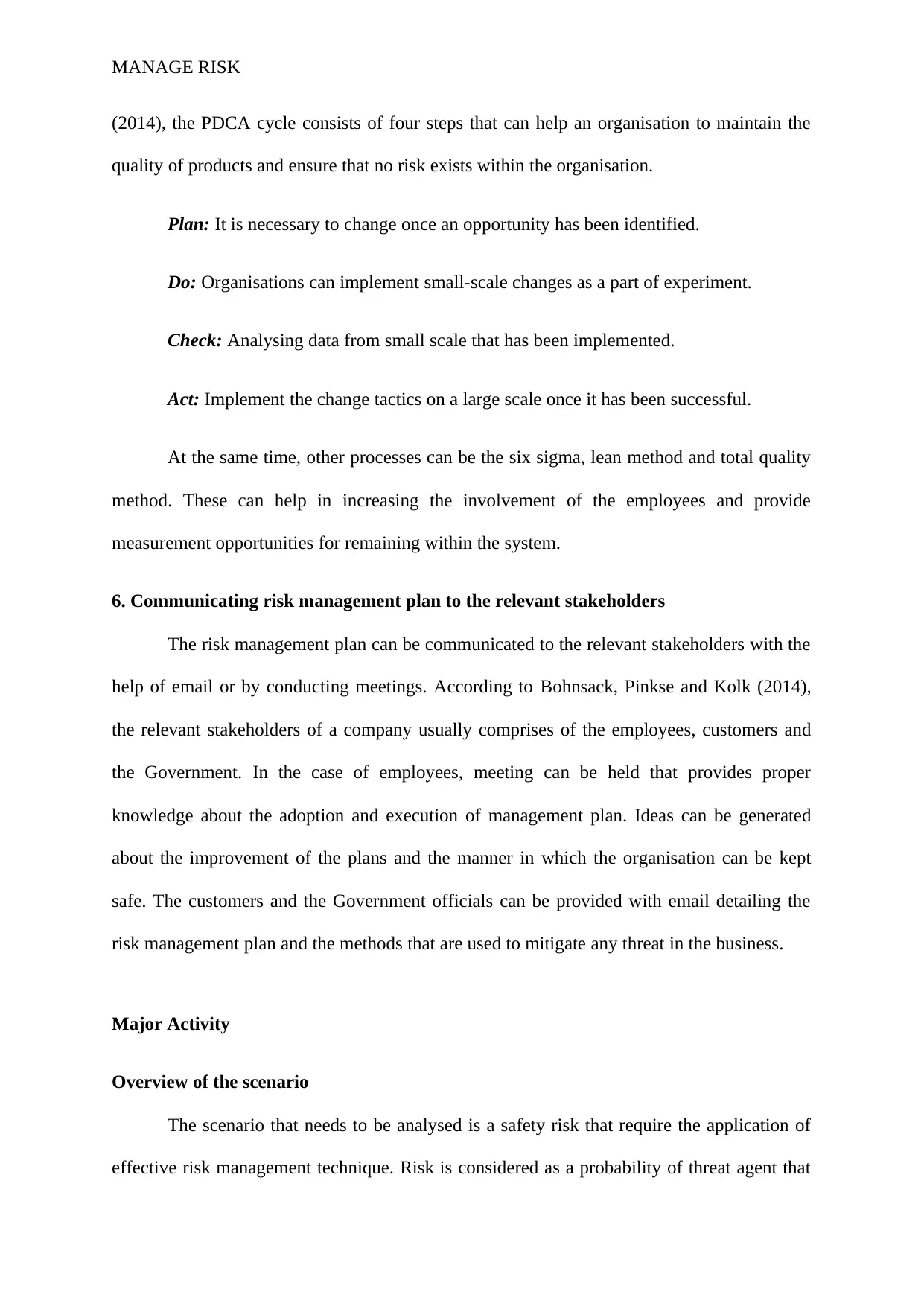
MANAGE RISK
(2014), the PDCA cycle consists of four steps that can help an organisation to maintain the
quality of products and ensure that no risk exists within the organisation.
Plan: It is necessary to change once an opportunity has been identified.
Do: Organisations can implement small-scale changes as a part of experiment.
Check: Analysing data from small scale that has been implemented.
Act: Implement the change tactics on a large scale once it has been successful.
At the same time, other processes can be the six sigma, lean method and total quality
method. These can help in increasing the involvement of the employees and provide
measurement opportunities for remaining within the system.
6. Communicating risk management plan to the relevant stakeholders
The risk management plan can be communicated to the relevant stakeholders with the
help of email or by conducting meetings. According to Bohnsack, Pinkse and Kolk (2014),
the relevant stakeholders of a company usually comprises of the employees, customers and
the Government. In the case of employees, meeting can be held that provides proper
knowledge about the adoption and execution of management plan. Ideas can be generated
about the improvement of the plans and the manner in which the organisation can be kept
safe. The customers and the Government officials can be provided with email detailing the
risk management plan and the methods that are used to mitigate any threat in the business.
Major Activity
Overview of the scenario
The scenario that needs to be analysed is a safety risk that require the application of
effective risk management technique. Risk is considered as a probability of threat agent that
(2014), the PDCA cycle consists of four steps that can help an organisation to maintain the
quality of products and ensure that no risk exists within the organisation.
Plan: It is necessary to change once an opportunity has been identified.
Do: Organisations can implement small-scale changes as a part of experiment.
Check: Analysing data from small scale that has been implemented.
Act: Implement the change tactics on a large scale once it has been successful.
At the same time, other processes can be the six sigma, lean method and total quality
method. These can help in increasing the involvement of the employees and provide
measurement opportunities for remaining within the system.
6. Communicating risk management plan to the relevant stakeholders
The risk management plan can be communicated to the relevant stakeholders with the
help of email or by conducting meetings. According to Bohnsack, Pinkse and Kolk (2014),
the relevant stakeholders of a company usually comprises of the employees, customers and
the Government. In the case of employees, meeting can be held that provides proper
knowledge about the adoption and execution of management plan. Ideas can be generated
about the improvement of the plans and the manner in which the organisation can be kept
safe. The customers and the Government officials can be provided with email detailing the
risk management plan and the methods that are used to mitigate any threat in the business.
Major Activity
Overview of the scenario
The scenario that needs to be analysed is a safety risk that require the application of
effective risk management technique. Risk is considered as a probability of threat agent that
⊘ This is a preview!⊘
Do you want full access?
Subscribe today to unlock all pages.

Trusted by 1+ million students worldwide
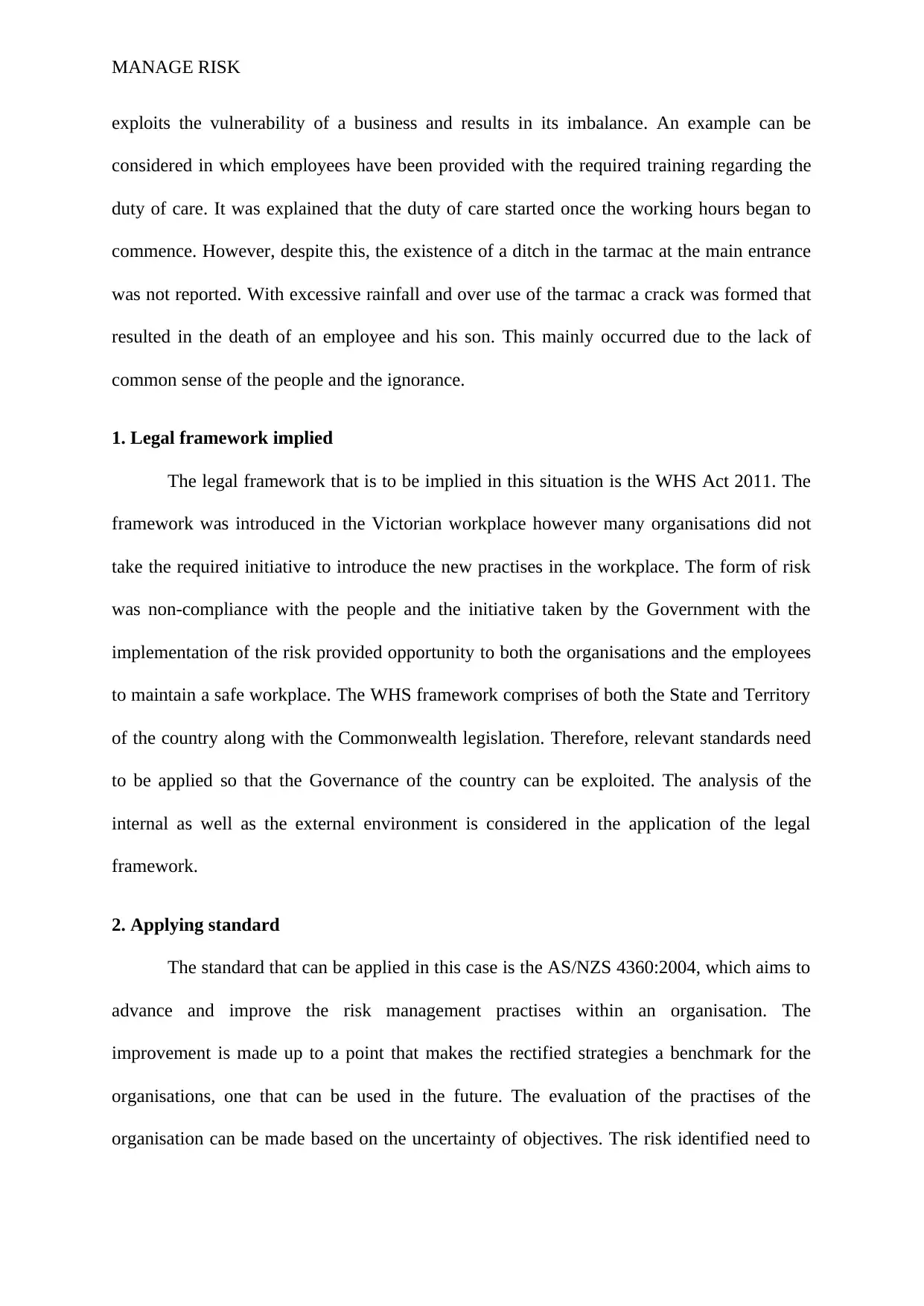
MANAGE RISK
exploits the vulnerability of a business and results in its imbalance. An example can be
considered in which employees have been provided with the required training regarding the
duty of care. It was explained that the duty of care started once the working hours began to
commence. However, despite this, the existence of a ditch in the tarmac at the main entrance
was not reported. With excessive rainfall and over use of the tarmac a crack was formed that
resulted in the death of an employee and his son. This mainly occurred due to the lack of
common sense of the people and the ignorance.
1. Legal framework implied
The legal framework that is to be implied in this situation is the WHS Act 2011. The
framework was introduced in the Victorian workplace however many organisations did not
take the required initiative to introduce the new practises in the workplace. The form of risk
was non-compliance with the people and the initiative taken by the Government with the
implementation of the risk provided opportunity to both the organisations and the employees
to maintain a safe workplace. The WHS framework comprises of both the State and Territory
of the country along with the Commonwealth legislation. Therefore, relevant standards need
to be applied so that the Governance of the country can be exploited. The analysis of the
internal as well as the external environment is considered in the application of the legal
framework.
2. Applying standard
The standard that can be applied in this case is the AS/NZS 4360:2004, which aims to
advance and improve the risk management practises within an organisation. The
improvement is made up to a point that makes the rectified strategies a benchmark for the
organisations, one that can be used in the future. The evaluation of the practises of the
organisation can be made based on the uncertainty of objectives. The risk identified need to
exploits the vulnerability of a business and results in its imbalance. An example can be
considered in which employees have been provided with the required training regarding the
duty of care. It was explained that the duty of care started once the working hours began to
commence. However, despite this, the existence of a ditch in the tarmac at the main entrance
was not reported. With excessive rainfall and over use of the tarmac a crack was formed that
resulted in the death of an employee and his son. This mainly occurred due to the lack of
common sense of the people and the ignorance.
1. Legal framework implied
The legal framework that is to be implied in this situation is the WHS Act 2011. The
framework was introduced in the Victorian workplace however many organisations did not
take the required initiative to introduce the new practises in the workplace. The form of risk
was non-compliance with the people and the initiative taken by the Government with the
implementation of the risk provided opportunity to both the organisations and the employees
to maintain a safe workplace. The WHS framework comprises of both the State and Territory
of the country along with the Commonwealth legislation. Therefore, relevant standards need
to be applied so that the Governance of the country can be exploited. The analysis of the
internal as well as the external environment is considered in the application of the legal
framework.
2. Applying standard
The standard that can be applied in this case is the AS/NZS 4360:2004, which aims to
advance and improve the risk management practises within an organisation. The
improvement is made up to a point that makes the rectified strategies a benchmark for the
organisations, one that can be used in the future. The evaluation of the practises of the
organisation can be made based on the uncertainty of objectives. The risk identified need to
Paraphrase This Document
Need a fresh take? Get an instant paraphrase of this document with our AI Paraphraser
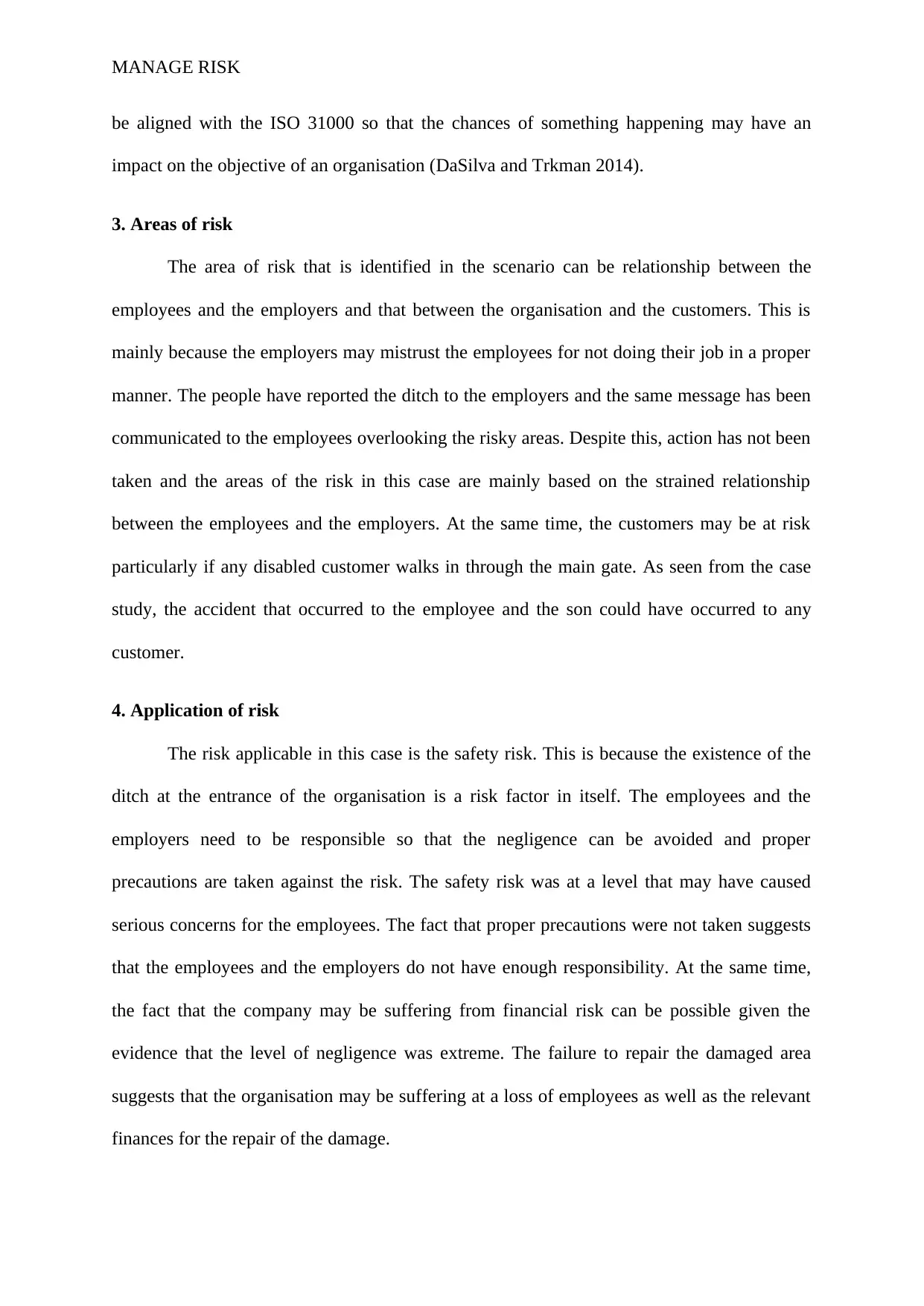
MANAGE RISK
be aligned with the ISO 31000 so that the chances of something happening may have an
impact on the objective of an organisation (DaSilva and Trkman 2014).
3. Areas of risk
The area of risk that is identified in the scenario can be relationship between the
employees and the employers and that between the organisation and the customers. This is
mainly because the employers may mistrust the employees for not doing their job in a proper
manner. The people have reported the ditch to the employers and the same message has been
communicated to the employees overlooking the risky areas. Despite this, action has not been
taken and the areas of the risk in this case are mainly based on the strained relationship
between the employees and the employers. At the same time, the customers may be at risk
particularly if any disabled customer walks in through the main gate. As seen from the case
study, the accident that occurred to the employee and the son could have occurred to any
customer.
4. Application of risk
The risk applicable in this case is the safety risk. This is because the existence of the
ditch at the entrance of the organisation is a risk factor in itself. The employees and the
employers need to be responsible so that the negligence can be avoided and proper
precautions are taken against the risk. The safety risk was at a level that may have caused
serious concerns for the employees. The fact that proper precautions were not taken suggests
that the employees and the employers do not have enough responsibility. At the same time,
the fact that the company may be suffering from financial risk can be possible given the
evidence that the level of negligence was extreme. The failure to repair the damaged area
suggests that the organisation may be suffering at a loss of employees as well as the relevant
finances for the repair of the damage.
be aligned with the ISO 31000 so that the chances of something happening may have an
impact on the objective of an organisation (DaSilva and Trkman 2014).
3. Areas of risk
The area of risk that is identified in the scenario can be relationship between the
employees and the employers and that between the organisation and the customers. This is
mainly because the employers may mistrust the employees for not doing their job in a proper
manner. The people have reported the ditch to the employers and the same message has been
communicated to the employees overlooking the risky areas. Despite this, action has not been
taken and the areas of the risk in this case are mainly based on the strained relationship
between the employees and the employers. At the same time, the customers may be at risk
particularly if any disabled customer walks in through the main gate. As seen from the case
study, the accident that occurred to the employee and the son could have occurred to any
customer.
4. Application of risk
The risk applicable in this case is the safety risk. This is because the existence of the
ditch at the entrance of the organisation is a risk factor in itself. The employees and the
employers need to be responsible so that the negligence can be avoided and proper
precautions are taken against the risk. The safety risk was at a level that may have caused
serious concerns for the employees. The fact that proper precautions were not taken suggests
that the employees and the employers do not have enough responsibility. At the same time,
the fact that the company may be suffering from financial risk can be possible given the
evidence that the level of negligence was extreme. The failure to repair the damaged area
suggests that the organisation may be suffering at a loss of employees as well as the relevant
finances for the repair of the damage.
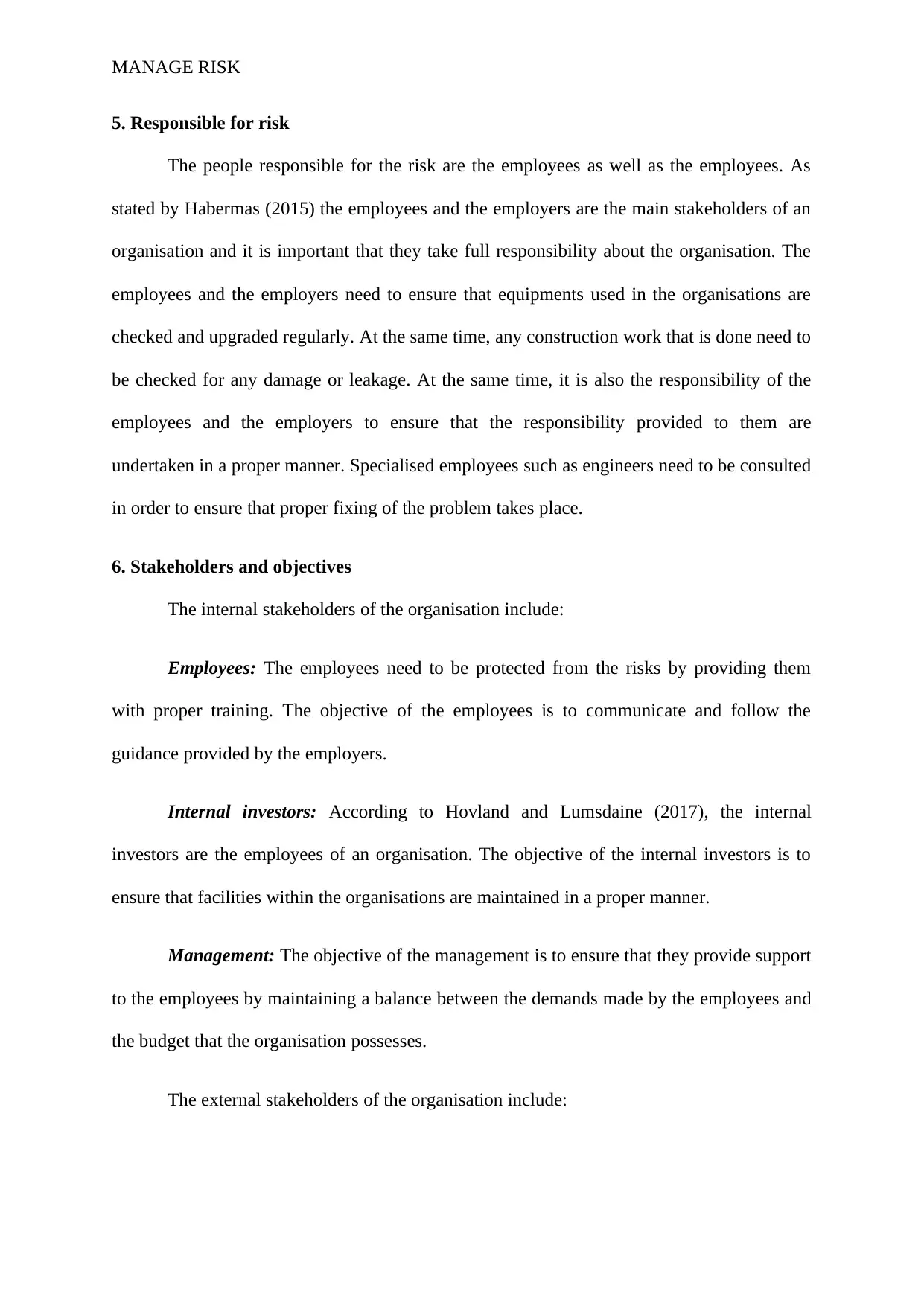
MANAGE RISK
5. Responsible for risk
The people responsible for the risk are the employees as well as the employees. As
stated by Habermas (2015) the employees and the employers are the main stakeholders of an
organisation and it is important that they take full responsibility about the organisation. The
employees and the employers need to ensure that equipments used in the organisations are
checked and upgraded regularly. At the same time, any construction work that is done need to
be checked for any damage or leakage. At the same time, it is also the responsibility of the
employees and the employers to ensure that the responsibility provided to them are
undertaken in a proper manner. Specialised employees such as engineers need to be consulted
in order to ensure that proper fixing of the problem takes place.
6. Stakeholders and objectives
The internal stakeholders of the organisation include:
Employees: The employees need to be protected from the risks by providing them
with proper training. The objective of the employees is to communicate and follow the
guidance provided by the employers.
Internal investors: According to Hovland and Lumsdaine (2017), the internal
investors are the employees of an organisation. The objective of the internal investors is to
ensure that facilities within the organisations are maintained in a proper manner.
Management: The objective of the management is to ensure that they provide support
to the employees by maintaining a balance between the demands made by the employees and
the budget that the organisation possesses.
The external stakeholders of the organisation include:
5. Responsible for risk
The people responsible for the risk are the employees as well as the employees. As
stated by Habermas (2015) the employees and the employers are the main stakeholders of an
organisation and it is important that they take full responsibility about the organisation. The
employees and the employers need to ensure that equipments used in the organisations are
checked and upgraded regularly. At the same time, any construction work that is done need to
be checked for any damage or leakage. At the same time, it is also the responsibility of the
employees and the employers to ensure that the responsibility provided to them are
undertaken in a proper manner. Specialised employees such as engineers need to be consulted
in order to ensure that proper fixing of the problem takes place.
6. Stakeholders and objectives
The internal stakeholders of the organisation include:
Employees: The employees need to be protected from the risks by providing them
with proper training. The objective of the employees is to communicate and follow the
guidance provided by the employers.
Internal investors: According to Hovland and Lumsdaine (2017), the internal
investors are the employees of an organisation. The objective of the internal investors is to
ensure that facilities within the organisations are maintained in a proper manner.
Management: The objective of the management is to ensure that they provide support
to the employees by maintaining a balance between the demands made by the employees and
the budget that the organisation possesses.
The external stakeholders of the organisation include:
⊘ This is a preview!⊘
Do you want full access?
Subscribe today to unlock all pages.

Trusted by 1+ million students worldwide
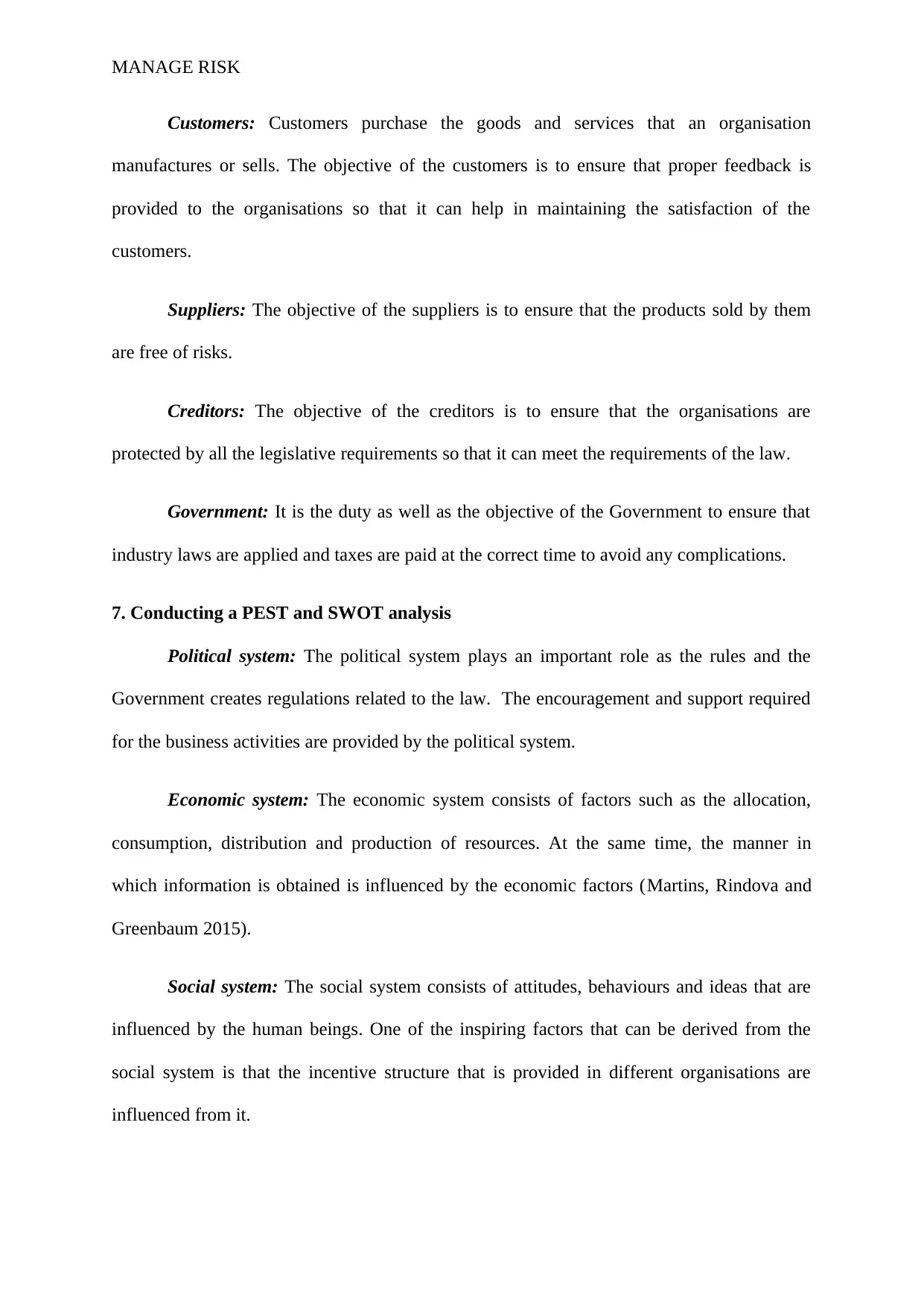
MANAGE RISK
Customers: Customers purchase the goods and services that an organisation
manufactures or sells. The objective of the customers is to ensure that proper feedback is
provided to the organisations so that it can help in maintaining the satisfaction of the
customers.
Suppliers: The objective of the suppliers is to ensure that the products sold by them
are free of risks.
Creditors: The objective of the creditors is to ensure that the organisations are
protected by all the legislative requirements so that it can meet the requirements of the law.
Government: It is the duty as well as the objective of the Government to ensure that
industry laws are applied and taxes are paid at the correct time to avoid any complications.
7. Conducting a PEST and SWOT analysis
Political system: The political system plays an important role as the rules and the
Government creates regulations related to the law. The encouragement and support required
for the business activities are provided by the political system.
Economic system: The economic system consists of factors such as the allocation,
consumption, distribution and production of resources. At the same time, the manner in
which information is obtained is influenced by the economic factors (Martins, Rindova and
Greenbaum 2015).
Social system: The social system consists of attitudes, behaviours and ideas that are
influenced by the human beings. One of the inspiring factors that can be derived from the
social system is that the incentive structure that is provided in different organisations are
influenced from it.
Customers: Customers purchase the goods and services that an organisation
manufactures or sells. The objective of the customers is to ensure that proper feedback is
provided to the organisations so that it can help in maintaining the satisfaction of the
customers.
Suppliers: The objective of the suppliers is to ensure that the products sold by them
are free of risks.
Creditors: The objective of the creditors is to ensure that the organisations are
protected by all the legislative requirements so that it can meet the requirements of the law.
Government: It is the duty as well as the objective of the Government to ensure that
industry laws are applied and taxes are paid at the correct time to avoid any complications.
7. Conducting a PEST and SWOT analysis
Political system: The political system plays an important role as the rules and the
Government creates regulations related to the law. The encouragement and support required
for the business activities are provided by the political system.
Economic system: The economic system consists of factors such as the allocation,
consumption, distribution and production of resources. At the same time, the manner in
which information is obtained is influenced by the economic factors (Martins, Rindova and
Greenbaum 2015).
Social system: The social system consists of attitudes, behaviours and ideas that are
influenced by the human beings. One of the inspiring factors that can be derived from the
social system is that the incentive structure that is provided in different organisations are
influenced from it.
Paraphrase This Document
Need a fresh take? Get an instant paraphrase of this document with our AI Paraphraser

MANAGE RISK
Technological system: In the modern world, technology plays an important role so
that productivity can be maintained. Purchasing and upgrading technology can help in the
development of organisations.
Strength
Have a proper risk assessment system
Support and loyalty of the staffs
Adopts a continuous risk management
process
Weakness
Lacks risk mitigation tactics
Casual attitude of the employees
Financial risks
Opportunity
Encourage the employees
Promote a safe working environment
Ensure legal laws are maintained
Threat
Competitors
Not maintaining proper safety
standards
Duty of care needs to be defined
Table 1: SWOT analysis
(Created by author)
8. Outlining influence of critical success factors
The Critical Success Factors (CSF) of the organisation includes the structuring and
designing of the organisation, communication and the organisational culture. According to
Mehrabian (2017), the importance and essence of risk management require the completion of
five activities such as top management support, participation of the employees, cultural
imperative and pattern of measurement. The CSF correlates with the pattern of values, ideas
and thoughts that help in supporting the risk management factors of the organisation. Hence,
the critical factors can help in managing the knowledge transfer that is required so that
exchange of information can help people to act together in an organisation. The
Technological system: In the modern world, technology plays an important role so
that productivity can be maintained. Purchasing and upgrading technology can help in the
development of organisations.
Strength
Have a proper risk assessment system
Support and loyalty of the staffs
Adopts a continuous risk management
process
Weakness
Lacks risk mitigation tactics
Casual attitude of the employees
Financial risks
Opportunity
Encourage the employees
Promote a safe working environment
Ensure legal laws are maintained
Threat
Competitors
Not maintaining proper safety
standards
Duty of care needs to be defined
Table 1: SWOT analysis
(Created by author)
8. Outlining influence of critical success factors
The Critical Success Factors (CSF) of the organisation includes the structuring and
designing of the organisation, communication and the organisational culture. According to
Mehrabian (2017), the importance and essence of risk management require the completion of
five activities such as top management support, participation of the employees, cultural
imperative and pattern of measurement. The CSF correlates with the pattern of values, ideas
and thoughts that help in supporting the risk management factors of the organisation. Hence,
the critical factors can help in managing the knowledge transfer that is required so that
exchange of information can help people to act together in an organisation. The
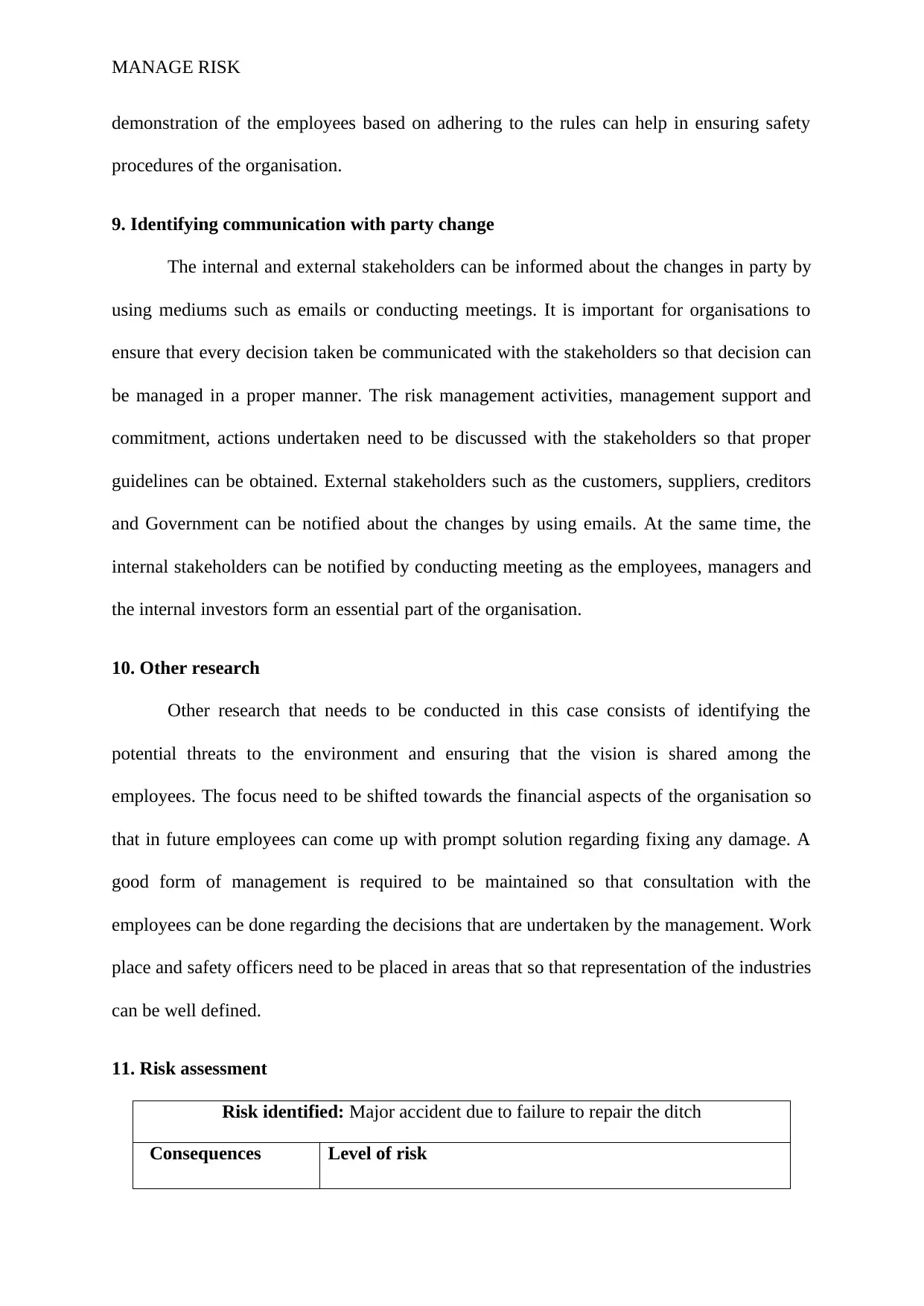
MANAGE RISK
demonstration of the employees based on adhering to the rules can help in ensuring safety
procedures of the organisation.
9. Identifying communication with party change
The internal and external stakeholders can be informed about the changes in party by
using mediums such as emails or conducting meetings. It is important for organisations to
ensure that every decision taken be communicated with the stakeholders so that decision can
be managed in a proper manner. The risk management activities, management support and
commitment, actions undertaken need to be discussed with the stakeholders so that proper
guidelines can be obtained. External stakeholders such as the customers, suppliers, creditors
and Government can be notified about the changes by using emails. At the same time, the
internal stakeholders can be notified by conducting meeting as the employees, managers and
the internal investors form an essential part of the organisation.
10. Other research
Other research that needs to be conducted in this case consists of identifying the
potential threats to the environment and ensuring that the vision is shared among the
employees. The focus need to be shifted towards the financial aspects of the organisation so
that in future employees can come up with prompt solution regarding fixing any damage. A
good form of management is required to be maintained so that consultation with the
employees can be done regarding the decisions that are undertaken by the management. Work
place and safety officers need to be placed in areas that so that representation of the industries
can be well defined.
11. Risk assessment
Risk identified: Major accident due to failure to repair the ditch
Consequences Level of risk
demonstration of the employees based on adhering to the rules can help in ensuring safety
procedures of the organisation.
9. Identifying communication with party change
The internal and external stakeholders can be informed about the changes in party by
using mediums such as emails or conducting meetings. It is important for organisations to
ensure that every decision taken be communicated with the stakeholders so that decision can
be managed in a proper manner. The risk management activities, management support and
commitment, actions undertaken need to be discussed with the stakeholders so that proper
guidelines can be obtained. External stakeholders such as the customers, suppliers, creditors
and Government can be notified about the changes by using emails. At the same time, the
internal stakeholders can be notified by conducting meeting as the employees, managers and
the internal investors form an essential part of the organisation.
10. Other research
Other research that needs to be conducted in this case consists of identifying the
potential threats to the environment and ensuring that the vision is shared among the
employees. The focus need to be shifted towards the financial aspects of the organisation so
that in future employees can come up with prompt solution regarding fixing any damage. A
good form of management is required to be maintained so that consultation with the
employees can be done regarding the decisions that are undertaken by the management. Work
place and safety officers need to be placed in areas that so that representation of the industries
can be well defined.
11. Risk assessment
Risk identified: Major accident due to failure to repair the ditch
Consequences Level of risk
⊘ This is a preview!⊘
Do you want full access?
Subscribe today to unlock all pages.

Trusted by 1+ million students worldwide
1 out of 21
Related Documents
Your All-in-One AI-Powered Toolkit for Academic Success.
+13062052269
info@desklib.com
Available 24*7 on WhatsApp / Email
![[object Object]](/_next/static/media/star-bottom.7253800d.svg)
Unlock your academic potential
Copyright © 2020–2025 A2Z Services. All Rights Reserved. Developed and managed by ZUCOL.





